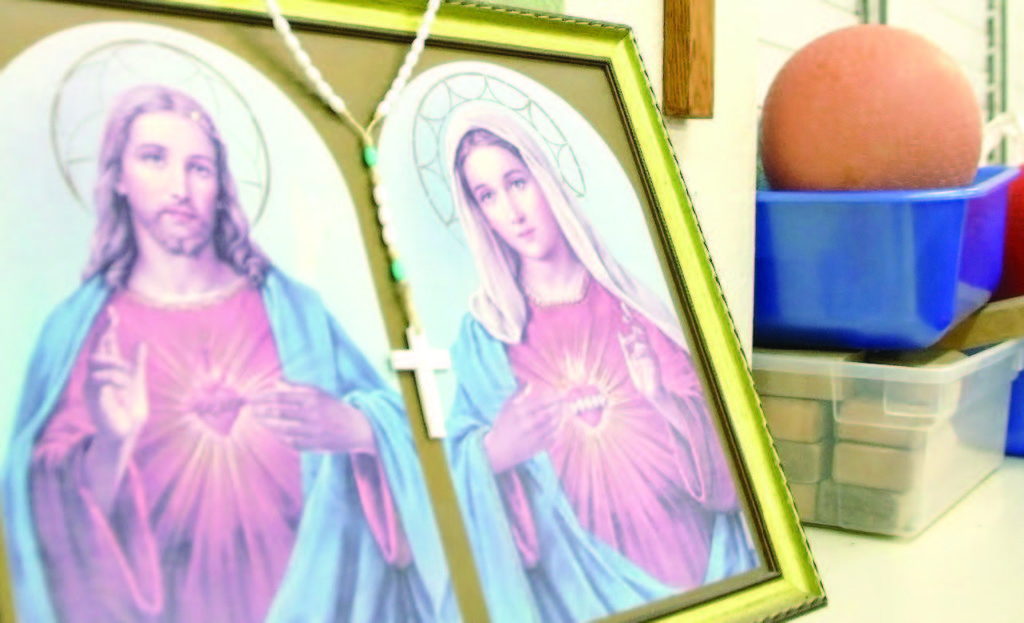HCS superintendent highlights strides and strengths in ‘Catholic identity’
This article was originally published in the Hawaii Catholic Herald on 8/10/2017.
By Darlene J.M. Dela Cruz, Hawaii Catholic Herald
“Catechists and Catholic school teachers of all subjects have a special role to play in handing on the faith to our children and youth and preparing them to be evangelizers.”
Faith formation for all ages is one of the priorities outlined in “Stewards of the Gospel,” the 2016- 2020 pastoral plan for the Diocese of Honolulu. Hawaii’s Catholic schools, the plan notes, “are an effective infrastructure” to nurture the next generation of faithful through school liturgies, campus ministries, service projects, religion classes and values-based education.
“Catholic identity” was the topic of discussion when Hawaii Catholic Schools superintendent Michael Rockers sat down with the Hawaii Catholic Herald Aug. 3. In light of the diocesan pastoral plan, the superintendent explored how Island Catholic school educators aim to be role models of the faith, and how a learning environment rooted in church teachings enriches everything from academics to athletics.
Superintendent Rockers said the term “Catholic identity” to him is “not just those standards on prayer and how often you have sacraments or how many signs and symbols are in the school.”
“It’s the way that the faculty and staff and hopefully the students embody that ministry and the things that they do,” he said. “It’s really to me when the kingdom of God is at hand.”
Quantitative and qualitative
Rockers explained that rubrics for evaluating a school’s Catholic identity are available through the Western Catholic Educational Association. The WCEA Accreditation Manual assess Catholic identity in seven categories: Mission and Philosophy; Prayer and Sacraments; Curriculum; Catechist Certification; Parents as Partners; Service; Signs and Sacramentals.

Photo by Darlene DelaCruz, Hawaii Catholic Herald
Schools are ranked “highly effective,” “effective,” “somewhat effective,” or “ineffective” based on standards outlined in these areas.
A “highly effective” rubric, for example, cites that “religion curriculum and teaching methodology are alive and vibrant in classrooms; aligned with Roman Catholic teachings; approved by the local Ordinary; and meet the requirements set forth by the USCCB (United States Conference of Catholic Bishops).”
A school is classified under an “ineffective” rubric if “there is no regular schedule or program for prayer and retreat experiences other than classroom prayer and Eucharistic liturgy on special occasions.”
The WCEA criteria provide a “quantitative” way to explain Catholic identity, superintendent Rockers said. He feels, however, that Catholic identity is also intangibly measured in a school’s “working with the Spirit.”
“Is it something that’s central to who they are or how they view the world?” he asked. “Are they really making disciples of Christ in the school?” The Hawaii Catholic Schools office, in collaboration with the diocese and other partners, offers a wealth of resources to ensure that local Catholic schools can continually strengthen their grounding in the faith.
Jayne Mondoy, director of the diocesan Office of Religious Education, has finalized local standards for religious instruction.
Superintendent Rockers worked with Mondoy on this and said these standards “correlate really nicely with the Catechism of the Catholic Church.”
Desired performance outcomes for children are based off the Catechism’s four major focuses — The Profession of Faith; The Celebration of the Christian Mystery; Life in Christ; Christian Prayer.
“It’s pretty strong,” Rockers said of the religious instruction standards. “The fullness of the Gospel that resides in the Catholic church is all the stuff that we teach.”
The superintendent explained that while the breadth of topics to be taught about the faith is immense, Catholic schools prioritize equipping students with a solid understanding of “the Trinity, the Incarnation and the Resurrection.” Catholic devotions, rituals and teachings — such as the rosary, saints, Mass, etc. — follow this foundation of our faith.
“There’s a way to inculcate, if these things (of faith) are true, what it means in society, and in social studies, science and all those things,” Rockers said.
Catholic schools have religion classes in all grades. In addition to Catholic identity in the core curriculum, schools offer faithbased activities. There are Catholic ministry groups such as Life Teen on campus, for example, and spiritual retreats are regularly held at Catholic sites such as St. Stephen Diocesan Center.
“From attending Mass to all the different classes, to service projects, to being the manager for the football team,” Rockers said, “serving in that way, if it’s all touched or blessed by faith and by the outlook that faith gives you, all of those things can be vehicles” for faith formation.
Role models of faith
Catholic school faculty, teachers and staff must as well keep up with faith formation and catechetical training.
New hires attend a mandatory personnel orientation — this year taking place on Aug. 13 — where among the subjects discussed are the history of Catholic schools in the U.S. and Hawaii, and canon law.
Catholic school educators and staff participate in the “Mass of the Holy Spirit” at the start of the school year, and the Annual Conference for Catholic School educators during National Catholic Schools Week.
The diocese recently launched a Lay Ecclesial Ministry Certification program, which requires teachers and catechists to take courses on theological foundations. Some courses are offered online through sites such as STEP Notre Dame and the University of Dayton Virtual Learning Community for Faith Formation.
In-person LEM Certification studies can be done at annual faith formation conferences, parish-based training programs or through the diocesan Office of Youth and Young Adult Ministry.
“The faith life of those teachers and who they are is really synonymous with the Catholic identity of the school,” superintendent Rockers explained.
“If you’ve got models of faith there and they talk the talk, and walk the walk, then all the activities and all the prayers and all those things are going to be enlivened by a spirit that causes the kids to really take it seriously.”
When asked what is the most challenging part of teaching the faith to students, Rockers said it depends on the age group. He does see “go-go-ism,” as he calls the ever-distracted society we live in, as a detriment to having youngsters fully commit to the depth of the Gospel.
“Students are so preoccupied with other things,” he said.
“You have to have your iPad, your phone, you’ve got to be multitasking much less busy at one thing. There’s no time to just sit and be present to the Lord.”
Good role models at school can present the faith in a modern-day context, the superintendent noted, challenging students to hold fast to values and behaviors that inspire them “to grow in Christ.”
“I don’t think students mind being challenged,” Rockers said.
He reflects on the Hawaii Catholic Schools office logo tagline, “Inspiring minds, sharing faith.” Rockers said all students – including non-Catholic youth and families – are “invited” to explore Catholic virtues and apply them in whatever ways meaningful for their homes and communities.
“It makes you look at the world differently,” he said.
Rockers said he is still molded by what was taught to him growing up in Catholic schools about the “richness” of Catholic traditions, but more importantly having a guide and savior in Jesus. Everything done to nurture Catholic identity in schools he hopes in some way will bear fruit for students and families in years to come.
Catholic identity “always has to be a front-burner thing,” Rockers said. “You throw seeds out there, sometimes later, it starts connecting.”






